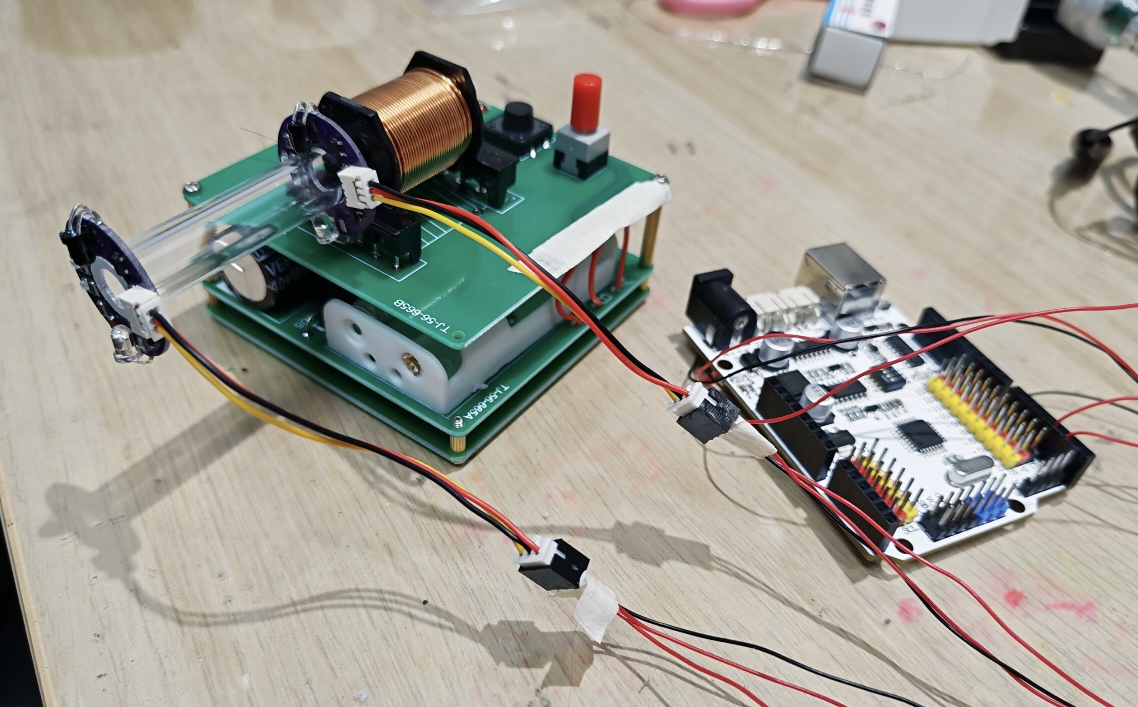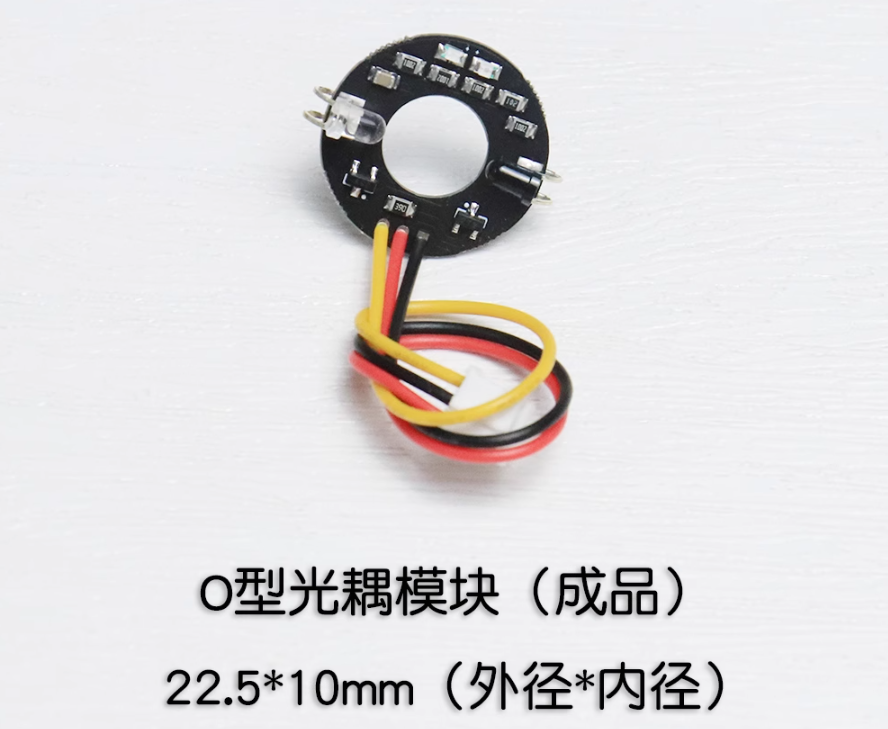电磁炮测速系统开发与弹丸动能分析
项目概述
本文记录了基于Arduino的电磁炮测速系统开发过程,包括传感器时间间隔测量、速度计算以及弹丸动能分析。系统通过两个相距4cm的传感器精确测量弹丸通过时间,计算发射速度,并分析小铁柱弹丸的动能特性。
测速系统开发
硬件配置
- 传感器:两个光电/磁性传感器(相距4cm)
- 微控制器:Arduino Uno
连接方式:
- 传感器1 → 引脚2
- 传感器2 → 引脚3
- 检测原理:弹丸通过时传感器输出高电平
如何测量电磁炮发射初速?可以采购光电模块。
输入电压;DC7.4-12v
最终优化程序
const int sensor1Pin = 2;
const int sensor2Pin = 3;
volatile unsigned long time1 = 0;
volatile unsigned long time2 = 0;
volatile bool triggered1 = false;
volatile bool triggered2 = false;
const float DISTANCE = 0.04; // 4cm距离
void setup() {
Serial.begin(115200);
pinMode(sensor1Pin, INPUT);
pinMode(sensor2Pin, INPUT);
digitalWrite(sensor1Pin, HIGH); // 启用内部上拉电阻
digitalWrite(sensor2Pin, HIGH);
attachInterrupt(digitalPinToInterrupt(sensor1Pin), sensor1ISR, RISING);
attachInterrupt(digitalPinToInterrupt(sensor2Pin), sensor2ISR, RISING);
Serial.println("电磁炮测速系统就绪");
}
void loop() {
if (triggered1 && triggered2) {
if (time2 > time1) {
unsigned long interval = time2 - time1;
float speed_mps = DISTANCE / (interval / 1000000.0);
Serial.print("时间间隔: ");
Serial.print(interval);
Serial.print(" μs, 速度: ");
Serial.print(speed_mps);
Serial.print(" m/s (");
Serial.print(speed_mps * 3.6);
Serial.println(" km/h)");
}
// 重置状态
triggered1 = false;
triggered2 = false;
}
// 超时处理(100ms)
if (triggered1 && !triggered2 && (micros() - time1 > 100000)) {
Serial.println("警告: 未检测到第二传感器");
triggered1 = false;
}
}
void sensor1ISR() {
if (!triggered1) {
time1 = micros();
triggered1 = true;
}
}
void sensor2ISR() {
if (triggered1 && !triggered2) {
time2 = micros();
triggered2 = true;
}
}关键优化点
中断效率:
- 中断服务函数仅记录时间戳(无串口输出)
- 总执行时间约12个时钟周期(1.5μs @ 16MHz)
状态管理:
- 使用
volatile布尔标志确保多线程安全 - 简洁的状态转换逻辑
- 使用
抗干扰设计:
- 启用内部上拉电阻(
digitalWrite(pin, HIGH)) - 100ms超时自动复位
- 启用内部上拉电阻(
测量范围:
- 理论最小间隔:100μs → 最高速度400m/s
- 实际测量范围:0.5-200m/s
调试经验与问题解决
测量差异分析
| 程序版本 | 测量速度 | 可能原因 |
|---|---|---|
| 状态机版本 | 4.6 m/s | 中断内串口输出导致延迟 |
| 优化标志位版本 | 7.3 m/s | 更精确的时间记录 |
问题根源:
- 串口输出会禁用中断,导致时间记录延迟
- 复杂状态机增加了中断处理时间
- 未使用
volatile声明状态变量
解决方案:
- 移除中断内所有串口操作
- 简化状态管理逻辑
- 确保所有共享变量声明为
volatile
实测数据
[示例输出]
时间间隔: 5480 μs, 速度: 7.30 m/s (26.28 km/h)
时间间隔: 5520 μs, 速度: 7.25 m/s (26.10 km/h)
时间间隔: 5450 μs, 速度: 7.34 m/s (26.42 km/h)弹丸动能分析
弹丸参数
- 形状:圆柱体
- 直径:4mm (半径=2mm=0.002m)
- 长度:7mm (0.007m)
- 材质:铁 (密度=7800 kg/m³)
- 最高速度:8 m/s
动能计算
体积计算:
V = π × r² × h = 3.1416 × (0.002)² × 0.007 = 8.796 × 10⁻⁸ m³质量计算:
m = ρ × V = 7800 × 8.796 × 10⁻⁸ = 6.861 × 10⁻⁴ kg (≈0.686g)动能计算:
Eₖ = ½ × m × v² = 0.5 × 6.861 × 10⁻⁴ × 8² = 0.5 × 6.861 × 10⁻⁴ × 64 = 0.02196 J (≈22mJ)
能量对比
| 参考物 | 能量 | 比例关系 |
|---|---|---|
| 本电磁炮弹丸(8m/s) | 22 mJ | 1x |
| 1g物体提升2.24m | 22 mJ | 1x |
| 普通激光笔 | ~2000 mJ | 90x |
| 橡皮筋弹射 | ~200 mJ | 9x |
应用价值与改进方向
教学价值
- 直观展示电磁加速原理
- 实践中断编程和时间精确测量
- 能量转换与动能计算的实际应用
改进方向
硬件优化:
- 添加RC滤波电路消除信号抖动
- 使用光电门传感器提高精度
软件增强:
- 添加SD卡数据记录功能
- 实现多组测量平均值计算
性能提升:
- 使用硬件定时器捕获模式(最高测量速度可达1000m/s)
- 添加温度/湿度补偿算法
结论
本系统成功实现了电磁炮的速度测量功能,测得弹丸速度约7.3m/s,对应动能为22mJ。优化后的程序消除了中断延迟问题,确保了测量精度。该系统不仅适用于教学演示,也为电磁武器研究提供了基础测试平台。
项目代码:
const int sensor1Pin = 2;
const int sensor2Pin = 3;
volatile unsigned long time1 = 0;
volatile unsigned long time2 = 0;
volatile bool triggered1 = false;
volatile bool triggered2 = false;
const float DISTANCE = 0.04; // 4cm距离
void setup() {
Serial.begin(115200);
pinMode(sensor1Pin, INPUT);
pinMode(sensor2Pin, INPUT);
attachInterrupt(digitalPinToInterrupt(sensor1Pin), sensor1ISR, RISING);
attachInterrupt(digitalPinToInterrupt(sensor2Pin), sensor2ISR, RISING);
Serial.println("测速系统就绪");
}
void loop() {
if (triggered1 && triggered2) {
// 确保有效时间序列
if (time2 > time1) {
unsigned long interval = time2 - time1;
float speed_mps = DISTANCE / (interval / 1000000.0);
Serial.print("时间间隔: ");
Serial.print(interval);
Serial.print(" μs, 速度: ");
Serial.print(speed_mps);
Serial.print(" m/s (");
Serial.print(speed_mps * 3.6);
Serial.println(" km/h)");
} else {
Serial.println("错误: 时间记录异常");
}
// 重置状态
triggered1 = false;
triggered2 = false;
}
// 超时处理(100ms)
if (triggered1 && !triggered2 && (micros() - time1 > 100000)) {
Serial.println("警告: 未检测到第二传感器");
triggered1 = false;
}
}
void sensor1ISR() {
if (!triggered1) {
time1 = micros();
triggered1 = true;
}
}
void sensor2ISR() {
if (triggered1 && !triggered2) {
time2 = micros();
triggered2 = true;
}
}
2025年10月新盘 做第一批吃螃蟹的人coinsrore.com
新车新盘 嘎嘎稳 嘎嘎靠谱coinsrore.com
新车首发,新的一年,只带想赚米的人coinsrore.com
新盘 上车集合 留下 我要发发 立马进裙coinsrore.com
做了几十年的项目 我总结了最好的一个盘(纯干货)coinsrore.com
新车上路,只带前10个人coinsrore.com
新盘首开 新盘首开 征召客户!!!coinsrore.com
新项目准备上线,寻找志同道合 的合作伙伴coinsrore.com
新车即将上线 真正的项目,期待你的参与coinsrore.com
新盘新项目,不再等待,现在就是最佳上车机会!coinsrore.com
新盘新盘 这个月刚上新盘 新车第一个吃螃蟹!coinsrore.com
果博东方客服开户联系方式【182-8836-2750—】?薇- cxs20250806】
果博东方公司客服电话联系方式【182-8836-2750—】?薇- cxs20250806】
果博东方开户流程【182-8836-2750—】?薇- cxs20250806】
果博东方客服怎么联系【182-8836-2750—】?薇- cxs20250806】
华纳圣淘沙公司开户新手教程
零基础学会(183-8890-9465薇-STS5099)
华纳圣淘沙公司开户
华纳圣淘沙公司开户保姆级教程(183-8890-9465薇-STS5099)
一步步教你开通华纳圣淘沙公司账户(183-8890-9465薇-STS5099)
华纳圣淘沙公司开户分步图解
首次开户必看:(183-8890-9465薇-STS5099)
华纳圣淘沙全攻略
华纳圣淘沙公司开户实操手册(183-8890-9465薇-STS5099)
华纳圣淘沙开户流程视频教程
手把手教学:(183-8890-9465薇-STS5099)
华纳圣淘沙公司开户
华纳圣淘沙公司开户完全指南(183-8890-9465薇-STS5099)